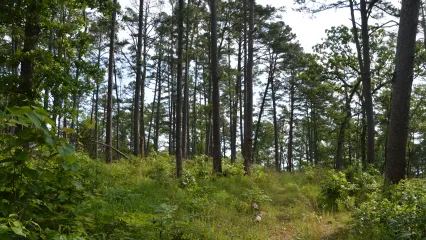With the creation of the McCurtain County Wilderness Area in October 1918, the Oklahoma Department of Wildlife Conservation invested in a legacy of land management that continues today. The state's first management area, encompassing 14,087 acres in far southeastern Oklahoma, stands out as the largest remaining patch of mature shortleaf pine-hardwood forest in the nation.

Towering pines mingle with a variety of oaks and other hardwoods on the area's sometime steep slopes. Grasses and wildflowers flourish underneath the lofty giants. This open, park-like scene, reminiscent of the southern forest's historical condition, is favored habitat for the federally endangered red-cockaded woodpecker. And while this woodpecker's life cycle shapes much of the Wildlife Department's workload on this wilderness area, the management team knows woodpeckers aren't the only beneficiaries of their daily efforts.
"When we provide habitat for the woodpeckers, we're providing habitat for a number of other species, from insects to game birds like turkey and quail, to larger mammals like deer," said Clay Barnes, a wildlife biologist for the Wildlife Department who oversees the area. "So many species are thriving under the umbrella of woodpecker management."
After years of active management, biologists and hunters have noticed an increase in the area's wildlife. "Surveys have shown a positive response in many songbirds. And deer and turkey hunters regularly observe and harvest their game as part of the area's limited controlled hunts program.
So what's in the recipe that creates the open habitat and resulting wildlife boost? Biologists such as Barnes and his predecessors have been applying prescribed fire across the area on a three-year rotation.
"We know the area has had a long fire history, both from natural lightning fires and man-made fires started by Native Americans. We're just continuing that history."
Users may experience the open forests and local wildlife with a visit to the McCurtain County Wilderness Area's nature trail, on the area's western unit. Hiking and backpacking permits for the area east of Broken Bow Lake may be secured by contacting the area's biologist at least two weeks before planned arrival.
All visitors are required to possess a conservation passport or valid Oklahoma hunting or fishing license to enter the management area.